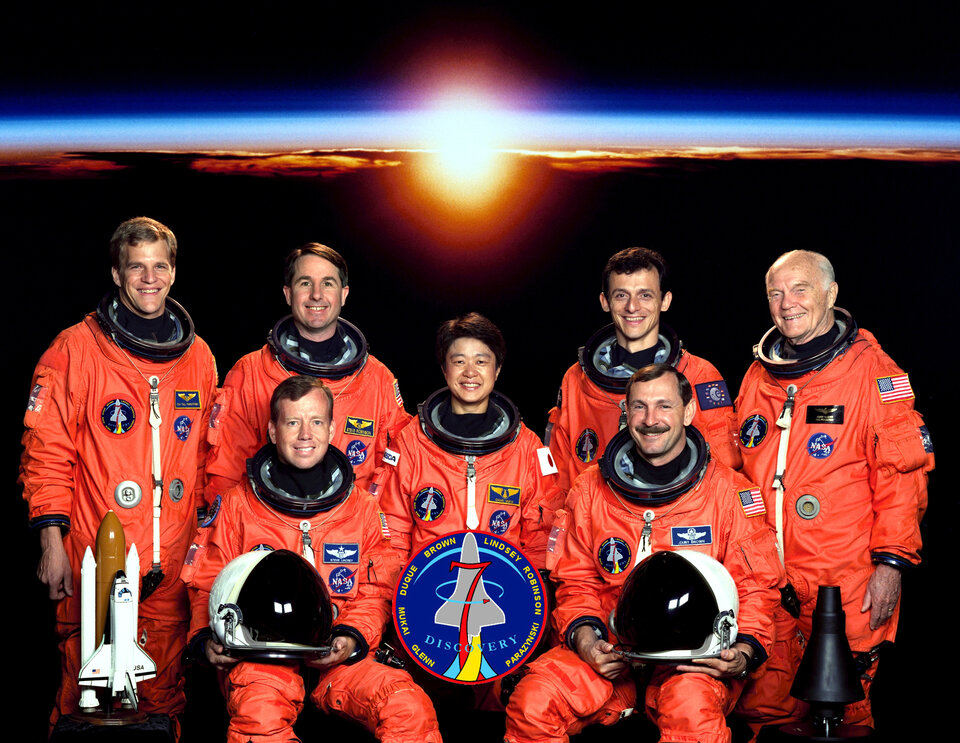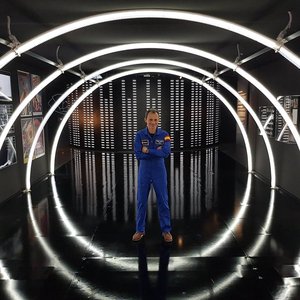SpaceHab
MISSION STATISTICS
Mission name: STS-95
Shuttle: Discovery
Number of crew members: 7
Launch:
29 October 1998, 02:20:19 p.m. EST
Landing:
7 November 1998, 12:04 p.m. EST, KSC, Runway 33
Duration: 8 days, 21 hours, 44 minutes, 56 seconds
Number of orbits: 134
CREW
- Curtis L. Brown (5), Commander
- Steven W. Lindsey (2), Pilot
- Scott E. Parazynski (3), Mission Specialist
- Stephen K. Robinson (2), Payload Commander
- Pedro Duque (1), Mission Specialist - ESA Spain
- Chiaki Mukai (2), Payload Specialist - NASDA
- John H. Glenn (2), Payload Specialist
(1) number of spaceflights each crew member has completed, including this mission

MISSION HIGHLIGHTS
The primary objectives included conducting a variety of science experiments in the pressurized SPACEHAB module, the deployment and retrieval of the Spartan free-flyer payload, and operations with the HST Orbiting Systems Test (HOST) and the International Extreme Ultraviolet Hitchhiker (IEH) payloads carried in the payload bay.
The SPACEHAB module flown on STS-95 was provided by SPACEHAB Inc., a private company which provides single or double module Spacehabs to support NASA's space flight efforts. The SPACEHAB system provides additional pressurized workspace for experiments, cargo and crew activities. SPACEHAB modules have supported various Shuttle science missions along with several of the joint Shuttle-Mir missions.
For STS-95, a single-module SPACEHAB flew in the forward portion of Discovery's payload bay with the crew gaining access to the module through the airlock tunnel system. A variety of experiments sponsored by NASA, the Japanese Space Agency (NASDA) and the European Space Agency (ESA) focused on life sciences, microgravity sciences and advanced technology during the flight.
The Spartan 201 free-flyer was deployed and retrieved using the Shuttle's mechanical arm and is designed to investigate physical conditions and processes of the hot outer layers of the Sun's atmosphere, or solar corona. While deployed from the Shuttle, Spartan gathered measurements of the solar corona and solar wind. Information collected during this mission will lead to a much better understanding of the solar winds that directly influence orbiting satellites and weather conditions on Earth which in turn impact television and phone communications. This is a reflight of the Spartan payload flown on Mission STS-87 in November 1997 which developed problems shortly after being deployed from the Shuttle.
The Hubble Space Telescope Orbiting Systems Test (HOST) platform carried experiments to validate components planned for installation during the third Hubble Space Telescope servicing mission and to evaluate new technologies in an earth orbiting environment. There were four experiments on the HOST platform.
The NICMOS Cooling System allowed zero-g verification of a Reverse Turbo Brayton Cycle Cooler which allows longer life operation than the current dewar system
The HST 486 Computer allows the identification of any radiation susceptible parts in the DF-224 replacement and demonstrate hardware and software responses to Single Event Upsets (SEU's)
Solid State Recorder compares on-orbit operation of the flight spare solid state recorder with the current HST unit
- Fiber Optic Line Test uses the same 4 kbit/s data stream that is sent to the orbiter's Payload Data Interrogator (PDI) and is routed to a laptop computer for post-flight comparison
The International Extreme Ultraviolet Hitchhiker (IEH) payload involves a half dozen different experiments mounted on a support structure which was carried in Discovery's payload bay.
The six experiments that make up the IEH payload are:
Solar Extreme Ultraviolet Hitchhiker (SEH) payload which obtained EUV and FUV fluxes that are required when studying the Earth's upper atmosphere
Ultraviolet Spectrograph Telescope for Astronomical Research (UVSTAR) payload designed to measure EUV fluxes which can be used to form images of extended plasma sources (ex. Jupiter, hot stars, etc.)
STAR-LITE payload which made observations of extended and diffused astrophysical targets
CONCAP-IV payload designed to grow thin films via physical vapor transport
Petite Amateur Navy Satellite (PANSAT) payload which is managed by the Department of Defense Space Test Program and involves a small deployable satellite that stores and transmits digital communications to PANSAT ground stations
- and a Getaway Special (GAS) payload
Since the aging process and a space flight experience share a number of similar physiological responses, a series of experiments sponsored by NASA and the National Institute on Aging was conducted on John Glenn during the STS-95 mission.
The investigations gathered information which may provide a model system to help scientists interested in understanding aging. Some of these similarities include bone and muscle loss, balance disorders and sleep disturbances. Data provided from John Glenn during this mission was compared to data obtained from Glenn's Friendship 7 orbital mission in 1962.
In addition to becoming the oldest person to fly into space, John Glenn also became the third seated politician to fly in space. At the time, John Glenn was the senior Senator out of Ohio. Senator Jake Garn (STS-51-D) and then-Representative (now Senator) Bill Nelson (STS-61-C) preceeded him in that distinction.





